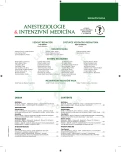Candid sepsis as a complication in a polytrauma patient
Authors:
Sas Igor; Straževská Eva; Hrdý Ondřej; Gál Roman
Authors‘ workplace:
Klinika anesteziologie, resuscitace a intenzivní medicíny, Fakultní nemocnice Brnoa Lékařská fakulta Masarykovy univerzity, Brno
Published in:
Anest. intenziv. Med., 25, 2014, č. 3, s. 212-215
Category:
Intesive Care Medicine - Case Report
Overview
We describe a case of a patient with traumatic rupture of the spleen and liver, which was complicated by candid sepsis. The infection was endogenous, originating from the bowel. Empirical therapy with echinocandin was started. The diagnosis was confirmed by finding Candida krusei and Candida glabrata in abdominal tube secretion culture and also in blood culture. The sepsis was successfully treated. The patient died because of complications not related to the candid sepsis.
Keywords:
traumatic rupture of spleen and liver – endogenous infection – candid sepsis – candidaemia – echinocandin
Sources
1. Wisplinghoff, H., Bischoff, T., Tallent, S. M., Seifert, H., Wenzel, R. P., Edmond, M. B. Nosocomial bloodstream infections in US hospitals: analysis of 24, 179 cases from a prospective nation-wide surveillance study. Clin. Infect. Dis., 2004, 39, p. 309–317.
2. Pfaller, M. A., Diekema, D. J. Epidemiology of invasive candidiasis: a persistent public health problem. Clin. Microbiol. Rev., 2007, 20, p. 133–163.
3. Shorr, A. F., Lazarus, D. R., Sherner, J. H., Jackson, W. L., Morrel, M., Fraser, V. J., Kollef, M. H. Do clinical features allow for accurate prediction of fungal pathogenesis in bloodstream infections? Potential implications of the increasing prevalence of non-albicans candidemia. Crit. Care Med., 2007, 35, p. 1077–1083.
4. Leon, C., Ruiz-Santana, S., Saavedra, P., Almirante, B., Nolla--Salas, J., Alvarez Lerma, F., Garnacho-Montero, J., Leon, M. A. A bedside scoring system (‘‘Candida score’’) for early antifungal treatment in nonneutropenic critically ill patients with Candida colonization. Crit. Care Med., 2006, 34, p. 730–737.
5. Fluckiger, U., Marchetti, O., Bille, J., Eggimann, P., Zimmerli, S., Imhof, A., Garbino, J., Ruef, C., Pittet, D., Tauber, M., Glauser, M.,Calandra, T. Treatment options of invasive fungal infections in adults. Swiss Med. Weekly, 2006, 136, p. 447–463.
6. Parkins, M. D., Sabuda, D. M., Elsayed, S., Laupland, K. B. Adequacy of empirical antifungal therapy and effect on outcome among patients with invasive Candida species infections.J. Antimicrob. Chemother., 2007, 60, p. 613–618.
7. Blumberg, H. M., Jarvis, W. R., Soucie, J. M., Edwards, J. E., Patterson, J. E., Pfaller, M. A., Rangel-Frausto, M. S., Rinaldi, M. G., Saiman, L., Wiblin, R. T., Wenzel, R. P. Risk factors for candidal bloodstream infections in surgical intensive care unit patients: the NEMIS prospective multicenter study. The National Epidemiology of Mycosis Survey. Clin. Infect. Dis., 2001, 33, p. 177–186.
8. Sobel, J. D., Rex, J. H. Invasive candidiasis: turning risk into a practical prevention policy? Clin. Infect. Dis., 2001, 33, p. 187–190.
9. Pappas, Peter G. et al. Clinical Practice Guidelines for the Management of Candidiasis: 2009 Update by the Infectious Diseases Society of America. Clinical Infectious Diseases, 2009, 48, p. 503-35. DOI 10.1086/596757
Labels
Anaesthesiology, Resuscitation and Inten Intensive Care MedicineArticle was published in
Anaesthesiology and Intensive Care Medicine

2014 Issue 3
Most read in this issue
- Postdural puncture headache in obstetrics
- The importance of thromboelastography (TEG) and thrombelastometry (ROTEM) in the intensive care unit
- Bougie-assisted cricothyrotomy on an animal model – a pilot study
- Candid sepsis as a complication in a polytrauma patient
